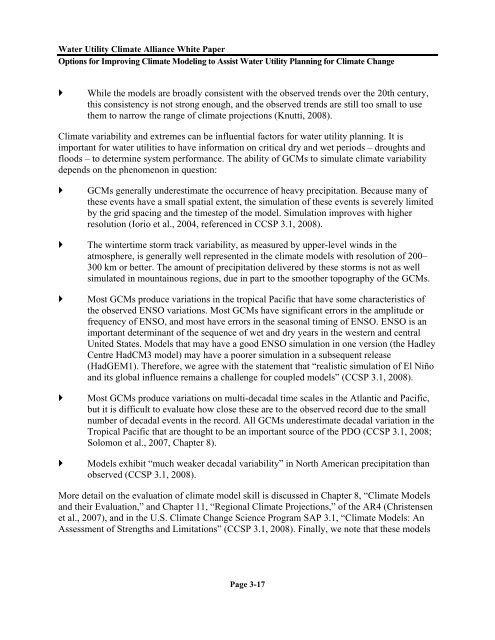Options for Improving Climate Modeling to Assist Water Utility ...
Options for Improving Climate Modeling to Assist Water Utility ...
Options for Improving Climate Modeling to Assist Water Utility ...
You also want an ePaper? Increase the reach of your titles
YUMPU automatically turns print PDFs into web optimized ePapers that Google loves.
<strong>Water</strong> <strong>Utility</strong> <strong>Climate</strong> Alliance White Paper<br />
<strong>Options</strong> <strong>for</strong> <strong>Improving</strong> <strong>Climate</strong> <strong>Modeling</strong> <strong>to</strong> <strong>Assist</strong> <strong>Water</strong> <strong>Utility</strong> Planning <strong>for</strong> <strong>Climate</strong> Change<br />
<br />
While the models are broadly consistent with the observed trends over the 20th century,<br />
this consistency is not strong enough, and the observed trends are still <strong>to</strong>o small <strong>to</strong> use<br />
them <strong>to</strong> narrow the range of climate projections (Knutti, 2008).<br />
<strong>Climate</strong> variability and extremes can be influential fac<strong>to</strong>rs <strong>for</strong> water utility planning. It is<br />
important <strong>for</strong> water utilities <strong>to</strong> have in<strong>for</strong>mation on critical dry and wet periods – droughts and<br />
floods – <strong>to</strong> determine system per<strong>for</strong>mance. The ability of GCMs <strong>to</strong> simulate climate variability<br />
depends on the phenomenon in question:<br />
<br />
<br />
<br />
<br />
<br />
GCMs generally underestimate the occurrence of heavy precipitation. Because many of<br />
these events have a small spatial extent, the simulation of these events is severely limited<br />
by the grid spacing and the timestep of the model. Simulation improves with higher<br />
resolution (Iorio et al., 2004, referenced in CCSP 3.1, 2008).<br />
The wintertime s<strong>to</strong>rm track variability, as measured by upper-level winds in the<br />
atmosphere, is generally well represented in the climate models with resolution of 200–<br />
300 km or better. The amount of precipitation delivered by these s<strong>to</strong>rms is not as well<br />
simulated in mountainous regions, due in part <strong>to</strong> the smoother <strong>to</strong>pography of the GCMs.<br />
Most GCMs produce variations in the tropical Pacific that have some characteristics of<br />
the observed ENSO variations. Most GCMs have significant errors in the amplitude or<br />
frequency of ENSO, and most have errors in the seasonal timing of ENSO. ENSO is an<br />
important determinant of the sequence of wet and dry years in the western and central<br />
United States. Models that may have a good ENSO simulation in one version (the Hadley<br />
Centre HadCM3 model) may have a poorer simulation in a subsequent release<br />
(HadGEM1). There<strong>for</strong>e, we agree with the statement that “realistic simulation of El Niño<br />
and its global influence remains a challenge <strong>for</strong> coupled models” (CCSP 3.1, 2008).<br />
Most GCMs produce variations on multi-decadal time scales in the Atlantic and Pacific,<br />
but it is difficult <strong>to</strong> evaluate how close these are <strong>to</strong> the observed record due <strong>to</strong> the small<br />
number of decadal events in the record. All GCMs underestimate decadal variation in the<br />
Tropical Pacific that are thought <strong>to</strong> be an important source of the PDO (CCSP 3.1, 2008;<br />
Solomon et al., 2007, Chapter 8).<br />
Models exhibit “much weaker decadal variability” in North American precipitation than<br />
observed (CCSP 3.1, 2008).<br />
More detail on the evaluation of climate model skill is discussed in Chapter 8, “<strong>Climate</strong> Models<br />
and their Evaluation,” and Chapter 11, “Regional <strong>Climate</strong> Projections,” of the AR4 (Christensen<br />
et al., 2007), and in the U.S. <strong>Climate</strong> Change Science Program SAP 3.1, “<strong>Climate</strong> Models: An<br />
Assessment of Strengths and Limitations” (CCSP 3.1, 2008). Finally, we note that these models<br />
Page 3-17

















